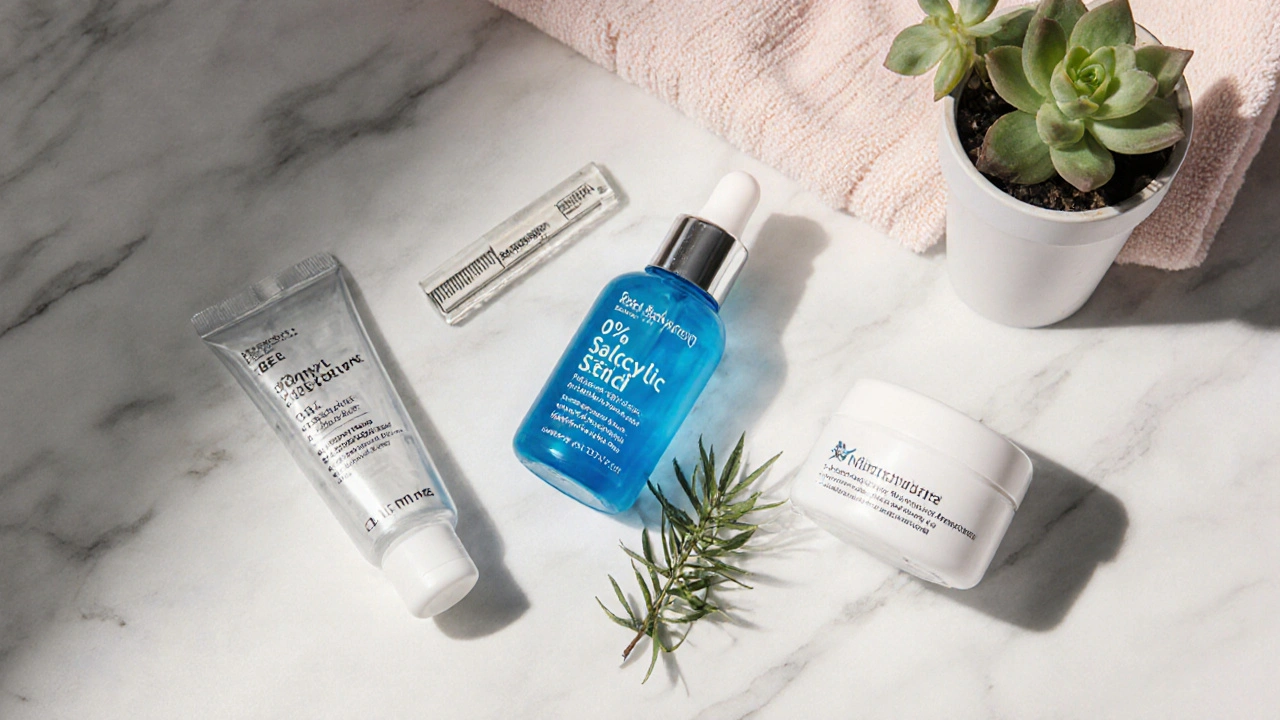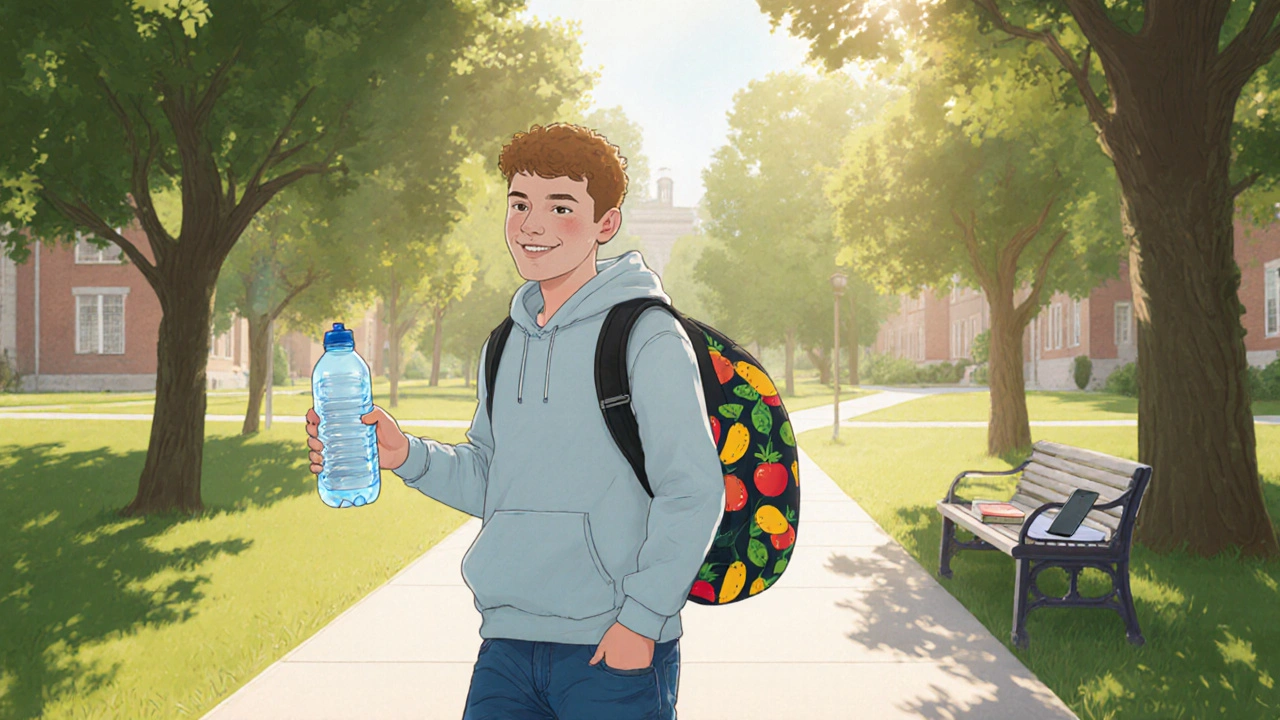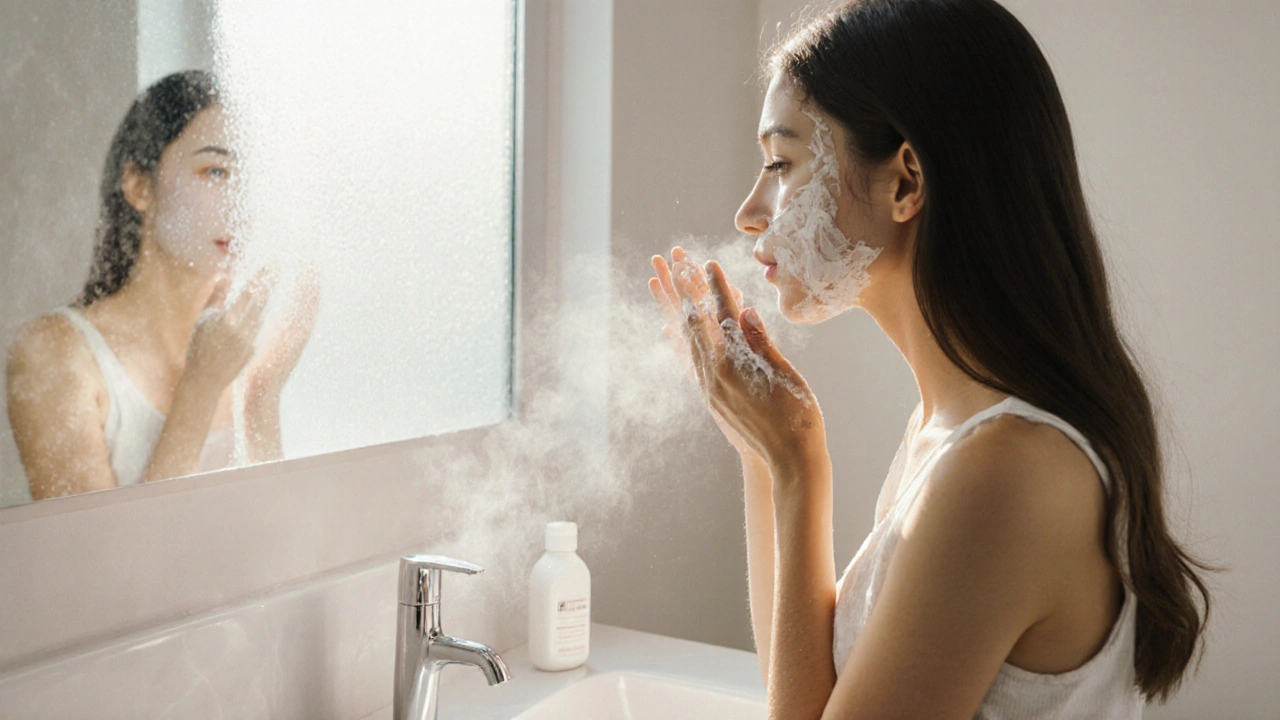6 Oct 2025
- 10 Comments
Acne Treatment Selector for Teens
Your Recommended Treatment Plan
Teen acne can feel like a never‑ending battle, but the right treatment can turn the tide fast. Below we break down the science‑backed options that actually clear skin without the drama.
Quick Takeaways
- Start with a gentle cleanser and an best acne treatments for teens that matches your skin type.
- Over‑the‑counter (OTC) actives-benzoyl peroxide, salicylic acid, and low‑strength retinoids-work for most mild‑to‑moderate cases.
- Prescription options (topical antibiotics, hormonal therapy) are best reserved for persistent or severe breakouts.
- Lifestyle tweaks-diet, stress management, and proper hygiene-boost any medical regimen.
- Consult a dermatologist if you notice scarring, cysts, or no improvement after 8‑12 weeks.
Understanding Teen Acne
Acne is a common skin condition where hair follicles clog with oil and dead skin cells, leading to whiteheads, blackheads, pimples, or cysts. During puberty, hormones called androgens surge, causing the sebaceous glands to produce more sebum. This excess oil, combined with bacterial overgrowth (Cutibacterium acnes), creates the perfect storm for breakouts.
For most teenagers, acne peaks between ages 14 and 17, then gradually eases. However, the emotional impact can be huge-studies show up to 30% of teens report low self‑esteem due to acne.
Key Players in Acne Treatment
Effective acne care relies on three pillars: kill the bacteria, unclog pores, and reduce inflammation. Below are the most evidence‑based actives that hit these targets.
1. Benzoyl peroxide an antibacterial and keratolytic that releases oxygen to kill acne‑causing bacteria and helps shed dead skin cells
- Typical OTC concentration: 2.5%-10%
- Works within a week for many users
- Potential side effects: dryness, mild redness, occasional bleaching of fabrics
2. Salicylic acid a beta‑hydroxy acid (BHA) that dissolves the glue holding dead skin cells together, keeping pores clear
- OTC strength usually 0.5%-2%
- Ideal for blackheads and oily skin
- May cause mild irritation if over‑applied
3. Retinoids VitaminA derivatives that speed up cell turnover, preventing clogged pores and improving post‑acne marks
- OTC options: adapalene 0.1% (Differin)
- Prescription: tretinoin, tazarotene
- Side effects: initial redness, peeling, photosensitivity-use sunscreen
4. Tea tree oil a natural essential oil with antimicrobial and anti‑inflammatory properties
- Effective concentration: 5%-10% in a carrier base
- Great for spot‑treating occasional pimples
- Can sting sensitive skin; patch test first
5. Hormonal Therapy
For girls who experience cyclical breakouts, combined oral contraceptives (COCs) can stabilize hormone spikes. Low‑dose COCs containing ethinyl estradiol and drospirenone are the most studied.
6. Professional Care
Dermatologist a skin‑care specialist who can prescribe stronger medications, perform extractions, or recommend procedures like laser therapy is the go‑to when OTC products fail or scarring appears.

How to Choose the Right Treatment for Your Teen
Pick a regimen based on three factors: acne severity, skin type, and tolerance for potential side effects.
- Mild (few whiteheads/blackheads) - Start with a gentle cleanser, then add a 2.5% benzoyl peroxide gel or 1% salicylic acid serum.
- Moderate (persistent papules, occasional pustules) - Combine a low‑strength retinoid (adapalene) with benzoyl peroxide on alternate nights.
- Severe (nodular cysts, extensive redness) - Seek dermatologist care for prescription oral antibiotics (e.g., doxycycline) or hormonal therapy.
Regardless of the chosen product, introduce one active at a time. This helps you gauge irritation and prevents over‑loading the skin.
Comparison of the Most Popular OTC Options
| Active | Mechanism | Typical Concentration | OTC? | Common Side Effects | Best For |
|---|---|---|---|---|---|
| Benzoyl Peroxide | Oxidizes bacteria, exfoliates | 2.5%-10% | Yes | Dryness, bleaching of fabrics | Inflammatory papules, quick‑kill needs |
| Salicylic Acid | Keratin dissolver, unclogs pores | 0.5%-2% | Yes | Mild irritation, dryness | Blackheads, oily skin |
| Retinoids (Adapalene) | Boosts cell turnover, anti‑inflammatory | 0.1% | Yes (OTC) | Peeling, photosensitivity | Post‑acne marks, comedonal acne |
| Tea Tree Oil | Antimicrobial, anti‑inflammatory | 5%-10% in carrier | Yes | Stinging, allergic reactions | Spot treatment, occasional flare‑ups |
Putting It All Together: A Sample Daily Routine
Here’s a realistic 6‑step routine that many teenagers find sustainable.
- Morning cleanse with a fragrance‑free, pH‑balanced cleanser.
- Apply a thin layer of 2.5% benzoyl peroxide on acne‑prone zones (avoid eyes).
- Moisturize with a non‑comedogenic, oil‑free lotion containing niacinamide to soothe inflammation.
- Apply broad‑spectrum SPF 30+ sunscreen - essential when using retinoids.
- Evening cleanse again, then use 0.1% adapalene (alternate nights if irritation occurs).
- Finish with a light moisturizer; if you have occasional red spots, dab a 5% tea tree oil spot‑treatment.
Give the regimen 8‑12 weeks before judging success. If you see no improvement, consult a dermatologist for possible prescription options.

Lifestyle Tweaks That Boost Results
- Diet: Reduce high‑glycemic foods (white bread, sugary drinks) which can spike insulin and worsen oil production.
- Hydration: Aim for 6‑8 glasses of water daily to support skin barrier function.
- Stress management: Practice brief mindfulness or exercise; cortisol can aggravate breakouts.
- Sleep: 7‑9 hours nightly helps skin repair and reduces inflammation.
- Hygiene: Change pillowcases weekly, keep phone screens clean, and avoid “popping” pimples.
When to See a Dermatologist
Even the best OTC regimen can fall short in certain cases. Book a specialist appointment if you notice any of these red flags:
- Deep, painful cysts that don’t respond after 6 weeks.
- Rapid spreading of lesions across the face or back.
- Persistent scarring or hyperpigmentation.
- Signs of infection (excessive redness, pus, fever).
A dermatologist might prescribe oral isotretinoin, laser therapy, or chemical peels-options that are out of reach for over‑the‑counter products.
Frequently Asked Questions
Can I use benzoyl peroxide and salicylic acid together?
It’s better to alternate them (e.g., benzoyl peroxide AM, salicylic acid PM) to avoid excessive dryness. If your skin tolerates both, you can use a combined product formulated with low concentrations of each.
Are over‑the‑counter retinoids safe for teenagers?
Yes, especially adapalene 0.1%, which is FDA‑approved for ages 12 and up. Start slowly, use sunscreen, and stop if severe irritation occurs.
Do diet changes really affect acne?
Research links high‑glycemic diets and dairy consumption to increased breakouts in some teens. Swapping sugary snacks for nuts, fruits, and whole grains often leads to clearer skin within weeks.
How long before I see results from a new treatment?
Most OTC actives show improvement in 4‑6 weeks, but full results may take 8‑12 weeks. Patience and consistent use are key.
Is it safe to use acne medication while pregnant?
Many topical treatments (like benzoyl peroxide and low‑strength salicylic acid) are considered low risk, but oral antibiotics and retinoids should be avoided unless prescribed by a healthcare professional. Always discuss with a doctor.
Bottom Line
Finding the best acne treatments for teens isn’t about a magic cure-it’s about matching the right active ingredients to your skin’s needs, supporting them with good habits, and knowing when to get professional help. Start simple, be consistent, and you’ll watch those stubborn spots fade away.


lee charlie
October 6, 2025Hey I get how frustrating acne can be for teens. Starting simple and staying consistent really helps. You don’t have to chase every new product.
Greg DiMedio
October 13, 2025Oh great another guide that tells you to wash your face. Groundbreaking stuff.
Badal Patel
October 20, 2025Esteemed reader, whilst your observation is noted, one must, of course, consider the profound depth inherent within dermatological discourse; indeed, the act of cleansing constitutes merely the inaugural step, scarcely the zenith of therapeutic strategy, does it not?
KIRAN nadarla
October 27, 2025The article rightly enumerates the primary actives-benzoyl peroxide, salicylic acid, and retinoids-yet it omits a quantitative risk‑benefit analysis. For instance, the prevalence of irritant dermatitis with benzoyl peroxide at concentrations above 5 % exceeds 30 %, a statistic that warrants discussion.
Kara Guilbert
November 2, 2025i cant belive u r ignoring the moral aspect of teen self‑esteem. acne is not just skin, its a mental health issue and n0 one should be so casual about it.
Sonia Michelle
November 9, 2025I appreciate the thoroughness of the guide and want to add a philosophical perspective.
Acne, while a physical condition, often mirrors the inner turbulence of adolescence.
When we treat the skin, we should also tend to the mind.
Consistency in a skincare routine can become a ritual that reinforces self‑discipline.
However, rigidity can backfire, so flexibility is essential.
Embrace the process as a learning journey rather than a quick fix.
Start with gentle cleansing, because aggression toward the skin can exacerbate inflammation.
Introduce actives one at a time, monitoring tolerance, which respects the skin’s natural barrier.
Nutrition and sleep are not optional adjuncts; they are foundational pillars.
Reducing high‑glycemic foods can modulate insulin spikes that fuel sebum production.
Stress management, through mindfulness or exercise, curtails cortisol‑driven oiliness.
If after eight weeks there is no noticeable improvement, seeking professional guidance is prudent.
Dermatologists can prescribe oral antibiotics, hormonal therapy, or isotretinoin, each with its own risk profile.
Remember that scarring is often a consequence of picking, not of the acne itself.
Ultimately, melding science with compassion equips teens to navigate this challenging phase with confidence.
Neil Collette
November 16, 2025Listen you’re missing the point that the regimen you described is oversimplified; teens actually need a graduated protocol with cycle‑off periods to prevent tachyphylaxis. Trust me I’ve read every study.
James Lee
November 23, 2025Ehh this post is like a shallow pond of wisdom-looks deep but you’re just splashing around.
Dennis Scholing
November 30, 2025Dear colleague, while the metaphor is vivid, I would advise focusing on evidence‑based steps rather than poetic analogies. A stepwise introduction of actives, coupled with barrier‑supporting moisturizers, yields reproducible results.
Kasey Lauren
December 7, 2025Stick with a routine and you’ll see progress.